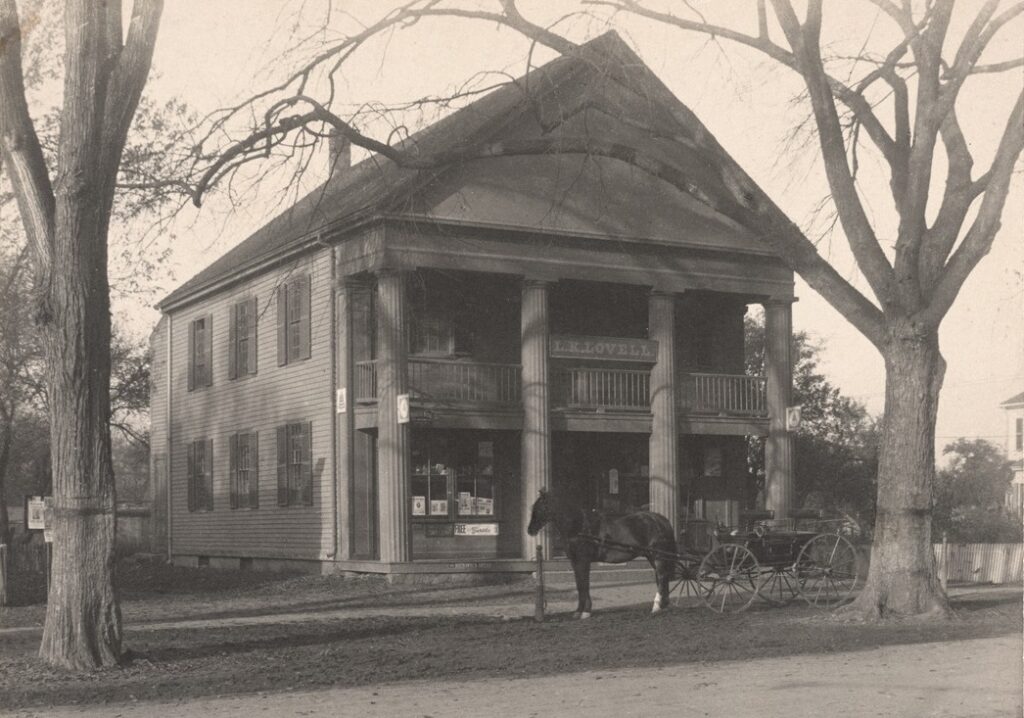
What Was It Like to Visit the Wayland Free Public Library in 1850?
Joseph M. Weisberg
In recent years, libraries have evolved from repositories of books and other printed materials into information centers where patrons can check out items ranging from ukuleles to birding kits and can even borrow books without leaving their homes. How does this experience compare to the one Waylanders would have encountered when the WFPL first opened its doors in 1850?
Unfortunately, there are no known photographs or drawings of the WFPL in its first location, the “Town House,” where the library was based for its first twenty-seven years of existence. We do know, however, that the library was first housed in the white-columned building known to some locals as Collins Market, which still stands only a few steps away from the WFPL’s current location. Instead, we must rely on textual descriptions to imagine what the library may have been like in the years before the Civil War. In particular, an 1851 speech by Reverend John Burt Wight and the earliest existing sets of library rules give us an idea of what the library room looked like and how its patrons may have used the space.

Wight described the library as “a spacious and convenient room, well painted, carpeted, lighted, warmed and furnished, with [a] book-case, table and chairs.”1 Wight may have overstated the attractiveness of the facilities, since he was advocating for a bill that would authorize the use of public funds for libraries. In fact, the library may not have been particularly spacious or convenient for all of its potential patrons. In 1861, the library moved to a larger room in the same building because it had outgrown the available shelf space in its initial location. Moreover, the convenience of the location in Wayland Center depended heavily on where potential library patrons lived. The library committee reported that fewer than twenty-five volumes reached Cochituate Village, about three miles south of Wayland Center, before the library began a program to deliver books to the area in 1874. Still, Wight provides an idea of the space: a small carpeted room, adequately furnished, with enough light and heat for reading.
For almost half a century, library patrons could visit only on Saturdays. This practice persisted for almost a half century, until the library finally expanded its hours in 1896. According to John Burt Wight, women and girls used the library during the two-hour block from 1 to 3 p.m. Men and boys arrived later when the library reopened for a second two-hour block from 7 to 9 p.m. Those patrons did not need library cards at first. Library regulations did not require a card until 1868, when that familiar token became the only method of obtaining books. However, even after the library card became standard, the process of obtaining books differed from present-day practices. Like many public libraries at the time, the WFPL did not allow patrons to enter the stacks and retrieve books for themselves. Instead, patrons were instructed to write the “shelf-numbers” of the books they wanted onto their library cards and present the card to the librarian, who would retrieve the books for them.2
Other aspects of the library have not changed much since the Wayland Town Library, as it was then known, first opened its doors almost 175 years ago. Although regulations originally limited borrowing to residents who were fourteen years old and older, children have always been an important part of the library’s patronage. For instance, the 1853 catalog listed over one hundred thirty titles under the heading “juvenile reading.” Contemporary patrons will also recognize the following excerpt from the WFPL’s earliest regulations: “No book shall be kept from the Library more than four weeks at one time, under penalty of ten per cent of its original cost or (if the book be given to the Library) estimated value for each weeks [sic] delay in its return.” Late fees would be a thorn in the side of library patrons until the WFPL decided to go “fine free” in 2021. Even today, late fees have not totally disappeared from the WFPL, but the elimination of fines on books and other materials has proven to be a relief not only to patrons, but to library staff.
Footnotes
1 John Burt Wight, “Our Common School System, No. XV.” Common School Journal 13, no. 17 (September 1851): 2. A copy of this publication is available in the Library – Miscellaneous collection at the WFPL.
2 For an example of this term, see Catalogue of the Public Library of the Town of Wayland (Boston: Franklin Press, 1875), 6.
Bibliography:
Beginnings of the Wayland Library. Unpublished. WFPL Archives.
First Record-Book, begun in 1850 by Henry Wight. Unpublished. WFPL Archives.
Library Catalogs [various years]. WFPL Archives.
Proceedings at the Dedication of the Town Hall, Wayland, December 24, 1878: With Brief Historical Sketches of Public Buildings and Libraries. Boston: Rockwell & Churchill, 1879.
“Report of the Library Trustees for the Year Ending February 28, 1896.” In Official Reports of the Town of Wayland, Vol. 4, 1893-1901.
Wiegand, Wayne A. Part of Our Lives: A People’s History of the American Public Library. New York: Oxford University Press, 2015.
Wight, John Burt. “Our Common School System, No. XV.” Common School Journal 13, no. 17 (September 1851): 257-264.